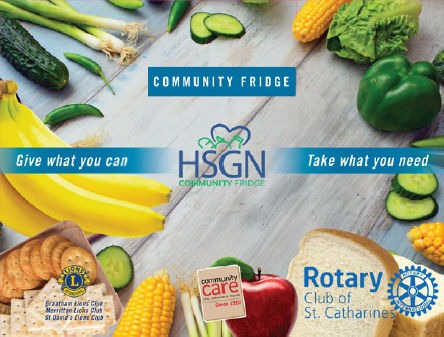
Building a more Humane Society
Give what you can. Take what you need. It sounds simple because it is simple. And yet, so many Canadians find themselves without enough food. How can this be true in a country that is so rich in agriculture and so successful in importing and exporting food to and from all over the world? This blog will explain household food insecurity in Canada and how the Humane Society’s Community Fridge aims to make a difference.
Hunger in Our Own Backyards
Based on the latest data from Statistics Canada’s Canadian Income Survey, 5.8 million Canadians, including 1.4 million children, live in food-insecure households. More than half a million people visit a food bank in Ontario every year. In 2022 there was a 64% increase in first time visitors to food banks across the province. The main drivers of this growth are disinvestments in social support programs, lack of good employment, the rise in the housing market, including large increases in the costs of utilities, and finally the increased cost of food and other necessities overall. We’ve all felt the squeeze on our wallets. From a loaf of bread now averaging five dollars to the amounts of cheese being half of what it used to be only a couple of years ago. Everything costs more money for less product. Minimum wage in Ontario doesn’t even come close to the increase in inflation. So how are people trying to live on it supposed to survive let alone thrive? The average room for rent is $700 a month and if you are in need of government assistance for living and they pay you an average of $600 a month, then you are forced to decide what’s more important – a roof over your head or food to eat. If you are married or have children, then the costs are much higher, but the ratio is the same. Homelessness and hunger can no longer be blamed solely on addictions and mental illness. We are now seeing young families on the corner holding signs that say, “We are hungry, anything helps.” This is a situation we thought we’d never see in our country, but we are, and the numbers are growing rapidly. Our governments are slowly attempting to address the problems but it’s taking much more time than it should with little difference being made. The crisis is real and it’s happening in our own backyards.
Food Insecurity
Food insecurity is the inadequate or insecure access to food due to financial constraints. It is a serious public health problem, a marker of pervasive material deprivation, and a matter of public policy.
Based on a household’s experience, they can be considered food secure or in one of 3 categories of food insecurity:
Marginal food insecurity: Worry about running out of food and/or limited food selection due to a lack of money for food.
Moderate food insecurity: Compromise in quality and/or quantity of food due to a lack of money for food.
Severe food insecurity: Miss meals, reduce food intake, and at the most extreme go day(s) without food.
You are what you eat. Not having enough food to eat can be detrimental to one’s health. Lacking the proper nutrition a body needs to be considered healthy can have long term affects not only on the individual but also on our health care system as a whole. A poor diet in both adults and children can lead to illnesses like diabetes, cancer, stunted growth, and inhibit cognitive development. This all not only puts weight on an individual in distress but also our general health care systems, using an excessive amount of resources it’s not currently designed to handle.
Community Awareness
By definition, a community is a number of people or families residing in a relatively small area within which they have developed socio-cultural definitions and by means of which they resolve problems arising from the sharing of an area. This means that food insecurity within a community is everyone’s problem and should be addressed by everyone within their means. During the covid pandemic people came together to check on their neighbours and the elderly to make sure they had everything they needed. This kind of empathy is in our nature and communities all over the country are coming together to help one another. Soup Kitchens and Food banks are excellent sources in the short term to relieve food insecurity. They are run by kind volunteers that regularly donate their time to help feed the less fortunate but as the number of the less fortunate is growing, these services might not be enough or able to keep up with the demand. This may no longer be an issue that can only be dealt with on a community level. A more long-term solution would be to implement policies on a government level by improving the financial circumstances of the average household. Food insecurity research tells us that our public policies have left low-income Canadians, particularly working age adults and their families, behind for a long time. The persistence of high rates of food insecurity is a clear sign that there needs to be a dedicated effort to restructure federal, provincial, and territorial policies to target food insecurity reduction and ensure Canadians have enough money for basic needs.
Implementing Action
Imagine a world where we all nourish each other, and the earth’s natural abundance is to be equally shared. This seems like a pipe dream, but it is possible, and The Humane Society of Greater Niagara is doing their part to make a difference. Recognizing the need and with a little help from their friends, in 2021 HSGN launched the first Community Fridge in the Niagara Region. As a part of a strong community and a compassionate city, they felt this was a natural step and capitalized on their location to further help those in need in the community. Constructed from a former cat gazebo, The Community Fridge is insulated and equipped with a large double-door fridge and two pantries to hold dry goods and some limited amounts of toiletries and hygiene products. Supplying fresh, healthy, and nutritious food isn’t something they can do alone. Partnerships with Community Care of St. Catharines and Thorold have helped to supply the fridge with their extra resources. Members of the community can also help by donating food, money or by volunteering to clean and stock the fridge. It’s not enough to recognize the problem, take action and be a part of the solution. Afterall, we’re all in this together and everyone is entitled to good, nutritious food.
